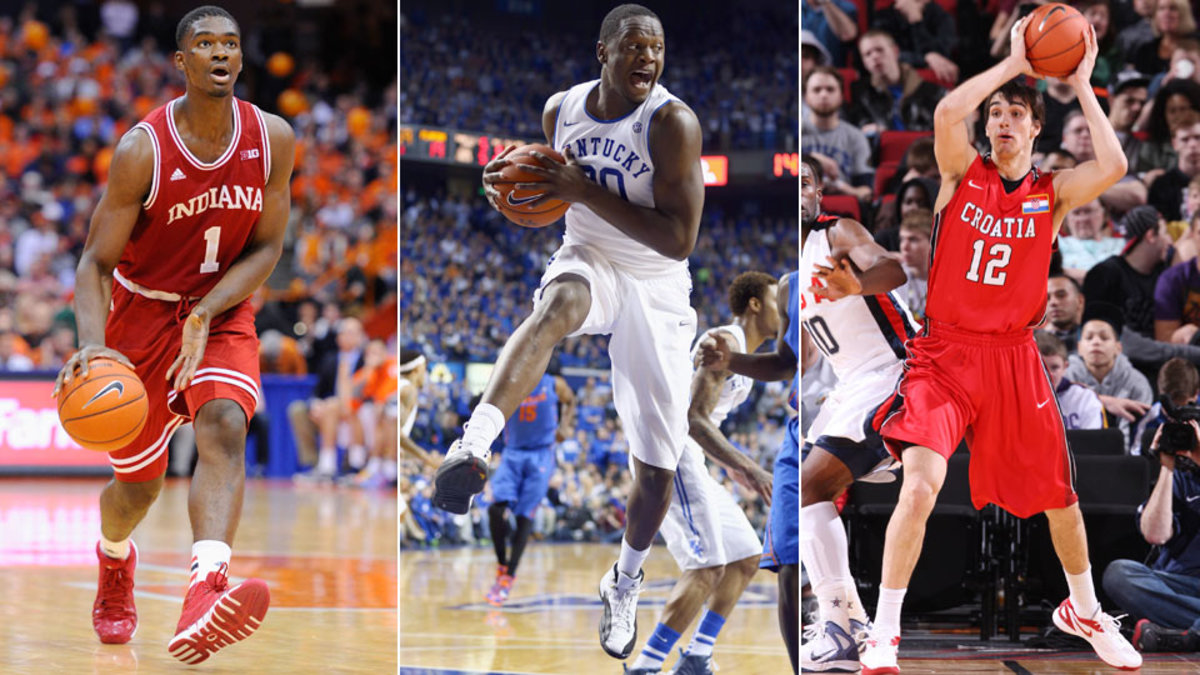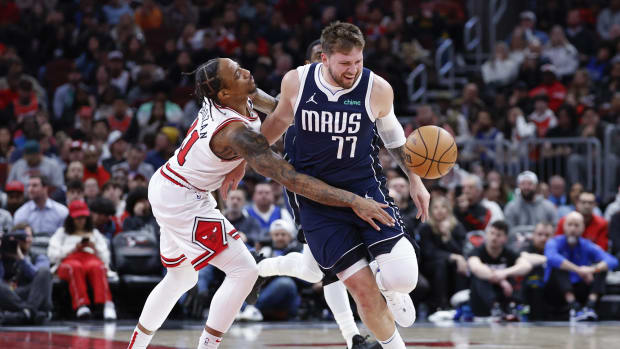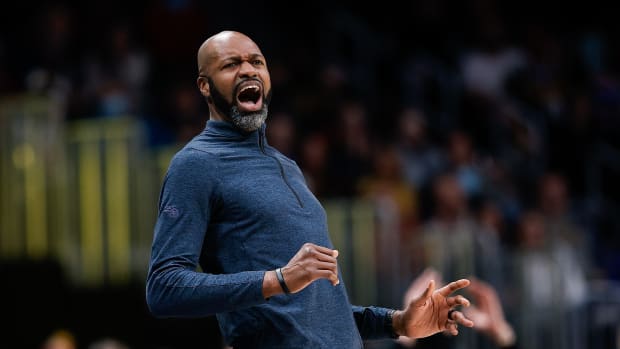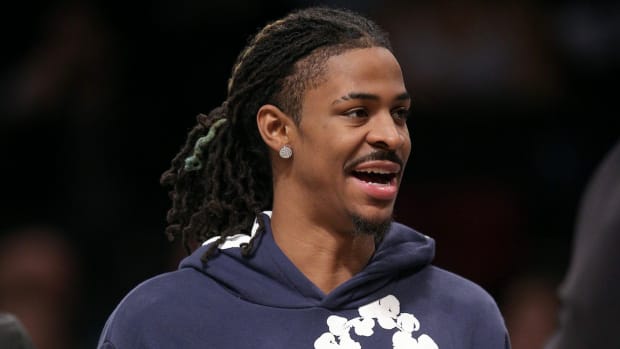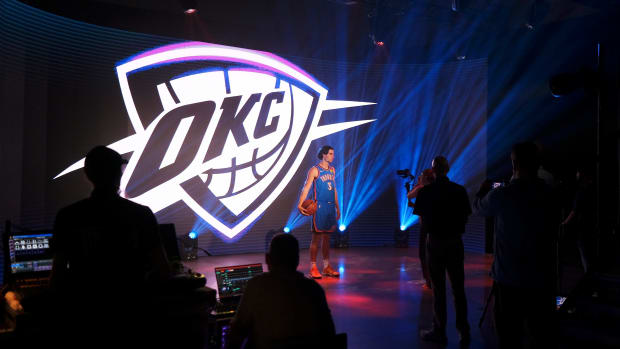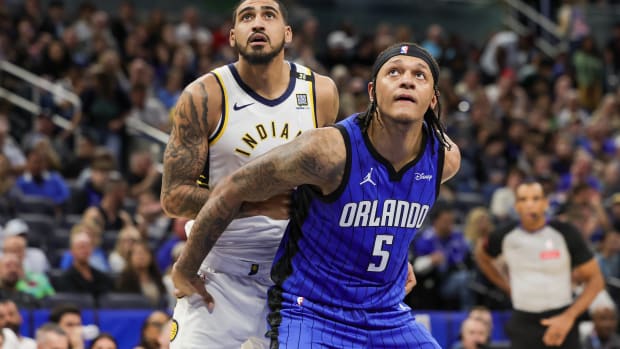NBA draft: Power forward rankings
With the 2014 NBA draft rapidly approaching, SI.com is providing positional rankings for the top prospects in this year’s class. We’ve already looked at the best point guards, shooting guards and small forwards. Today, we break down the top 10 power forwards.
1. Noah Vonleh (6-foot-9, 247 pounds)
Indiana, freshman | Age: 18
2013-14 stats: 11.3 points, 9.0 rebounds, 1.4 blocks, 52.3 FG%
Strengths: Perhaps Vonleh’s greatest strength is his work ethic. He once refused to go to Disney World with his family so that he could practice at a local YMCA. He also has an ideal physique for an NBA forward, with monstrous hands and a 7-4 wingspan. He is an exceptional rebounder, he hustles in transition and he showed great growth as a defensive player during his year at Indiana. Vonleh also displayed smart shot selection, connecting on 52.3 percent from the floor and a surprising 48.5 percent from beyond the arc (although he fired from deep only 33 times). Best of all, he won’t turn 19 until August, so the team that drafts Vonleh can expect even more gains.
Weaknesses: Despite that wise shot selection, Indiana would have liked for him to shoot -- and score -- more often. He has the skills and size to be an elite scorer, but still seems to lack confidence. In addition, he’ll have to transition from playing on the wing (in high school and at Indiana) to making a home in the low post. Fouls (he fouled out of two games and registered four fouls in eight more) and turnovers (2.1 per game, versus 0.6 assists) could be trouble as well. -- David Gardner
2. Julius Randle (6-9, 250)
Kentucky, freshman | Age: 19
2013-14 stats: 15 points, 10.4 rebounds, 1.4 assists, 0.8 blocks, 50 FG%
Strengths: Randle is one of the most NBA-ready players in this draft, with a pro body to go with a diverse skill set for his size. His ability to handle the ball, face up and take defenders off the dribble or back them down lets him exploit mismatches. When his jumper is on, he can pull big men away from the paint. He’s a bruiser who plays hard, and it’s easy to see his productivity on the interior translating to the NBA based on his motor. Players with Randle’s array of moves and mix of power and finesse are rare.
Weaknesses: Randle denied a Yahoo Sports report that he would need surgery on his right foot; teams will want to be fully educated on the injury situation before rolling the dice on draft night. Because of his size and strength, he’s made a living off bullying defenders to the basket, a strategy that will be much tougher as a professional. He’s left-hand dominant and rarely counters back to his right effectively -- a tendency taller, more athletic defenders in the NBA will sit on unless he improves. His jumper was inconsistent at Kentucky. Randle is not not a great shot-blocker and won’t provide a ton on the defensive end. Randle's upside might not be quite as high as other players in his draft range. -- Jeremy Woo
BUKOWSKI: Randle outshining Wiggins early
3.Aaron Gordon (6-9, 220)
Arizona, freshman | Age:18
2013-14 stats: 12.4 points, 8.0 rebounds, 2.0 assists, 1 block, 49.5 % FG
Strengths: An outstanding athlete and leaper, Gordon is a hybrid forward that does a bit of everything well. His greatest strength is his defense, as he’s active and able to guard multiple positions effectively. With the NBA’s stylistic shift toward more positionally fluid frontcourts, Gordon’s a unique piece that you can envision effectively meshing with different lineups. He’s unafraid to mix it up on the inside and strong on the glass, attacking the boards on the offensive end for easy points. Gordon runs the floor with ease and has improved his shooting some–you can see a bit of Shawn Marion in him and anything close to Marion’s career would be a great outcome. He’s also an above-average passer and a team player who doesn’t need the ball in order to be at his best. What’s more, Gordon doesn’t turn 19 until September. There’s a good chance he becomes a productive piece of someone’s puzzle, if not a star.
Weaknesses: The Blake Griffin comparisons are extremely lazy, as Gordon has little semblance of a post game and isn’t as physically dominant as Griffin was at the same stage. Though Griffin was raw certainly refined his game greatly in the NBA, he knew what he was the entire time -- Gordon wants to be a small forward, a transition that may prove difficult. He’s not highly skilled scoring off the dribble and is really a set shooter right now -- although he’s got three-point range, he has a ways to go before he can call himself a three-man. He also shot a measly 42.2 percent from the foul line, an alarming rate for any player, but especially frustrating for a player whose biggest long-term growth determinant is his jump shot. He’s a tweener, and teams will have to decide how to develop him, whether it’s fixing the jumper or teaching him post moves. There’s a chance Gordon never settles into a true position, which could limit his trajectory. -- JW
4. Dario Saric (6-10, 223)
Team: Cibona Zagreb (Croatia) | Country: Croatia | Age: 20
2013-14 stats (Adriatic League): 16.7 points, 9.7 rebounds, 3.2 assists, 1.3 steals, 49.7 FG%
Strengths: Saric has had quite a year, from featuring with the Croatian U-19 team to winning the Adriatic League MVP and leading Cibona to a domestic championship. Last year Saric was a projected lottery pick before pulling out of the draft, and his stock remains high. A point forward type who handles and passes well, Saric brings perhaps as much offensive versatility as any prospect in the class. He's also a willing rebounder, competes at a high level and is accustomed to success. There will be high expectations -- whenever he comes to the NBA.
Weaknesses:Though Saric kept his name in the draft, his father wants him to get more seasoning before making his American debut. A less-than-promising NBA situation could keep him overseas another year or two. Will Saric's camp be able to leverage its options into landing with a team it likes? Questions linger about his NBA position -- Saric may not be a good enough athlete to guard threes and doesn't shoot consistently enough as a stretch four. He’s at his playmaking best in a role where he can handle the ball, something teams have to consider as they attempt to slot him into their future plans. -- JW
WOO: 2014 NBA draft international prospect guide
5. Adreian Payne (6-10, 239)
Michigan State, senior | Age: 23
2013-14 stats: 16.4 points, 7.3 rebounds, 1.3 assists, 0.9 blocks, 50.3 FG%, 42.3 3FG%
Strengths: Payne is a stretch four who showed his excellent deep-shooting ability at Michigan State. He unknowingly played with mono for much of the season and still put up impressive numbers. He’s strong, has improved as a back-to-the-basket players and should be able to hold his own on the interior and on the glass. Payne’s a very good athlete and hard worker who improved in each of his four years with the Spartans. He boasts an inside-out game that should play immediately in a league where floor spacers are in high demand.
Predraft Q&A: Adreian Payne
Weaknesses: Despite good size and athleticism, Payne hasn't developed into a shot-blocker. He suffers from a condition that reduces his lung capacity and at times affected his stamina and playing time (he averaged 28.1 minutes as a senior). That situation has raised doubts about his ability to log heavy minutes in the NBA. His age, of course, has been mentioned repeatedly as a drawback. Payne doesn’t profile as a star, but in the middle of the first round, he seems like one of the safer bets to provide value. -- JW
WINN: As threes boom in NBA, Payne, McDermott are in-demand prospects
6. Clint Capela (6-11, 211)
Elan Chalon (France) | Country: Switzerland | Age: 20
2013-14 stats (French League): 9.4 points, 6.9 rebounds, 1.2 assists, 1.5 blocks, 63.2 FG%
Strengths:Regarded as one of the most athletic European players to ever enter the draft, Capela boasts an intriguing set of physical tools and has been compared with the Thunder's Serge Ibaka. He's coming off a promising season for Chalon and was an interior force in limited playing time (he averaged 22 minutes in league play). Capela moves exceptionally well, finishes effectively around the basket and blocks a lot of shots with his nearly 7-4 wingspan and enormous hands. Those traits help him play above the rim and catch lobs easily. His calling card is his rebounding, with natural instincts that help him grab boards outside of his area on both ends. He's an ideal candidate to draft and let develop overseas, with a chance for a big payoff down the line.
Weaknesses:Capela likes to face up and attack the basket, but he will need to keep honing his mid-range game to be more than just a garbage-man type at power forward. His decision-making isn’t great and there will inevitably be a learning curve for him before he can log NBA minutes. Capela has a long way to go skill-wise and could stand to beef up to handle the rigors of interior play. He’s a physical specimen but risky, a pick best made by one of the eight teams holding multiple first-round selections. -- JW
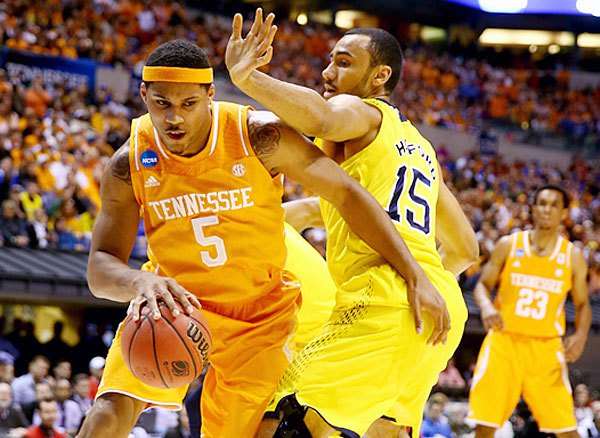
Jarnell Stokes averaged 15 points and 10.5 rebounds for the Vols last season.
(Andy Lyons/Getty Images)
7. Jarnell Stokes (6-8, 263)
Tennessee, junior | Age: 20
2013-14 stats: 15.0 points, 10.5 rebounds, 2.0 assists, 0.9 blocks, 53.5 FG%
Strengths: Stokes improved statistically in each of his three years at Tennessee, where he enrolled early out of high school. He was first-team All-SEC last season and propelled the Vols to an unlikely Sweet 16 run. He’s a load in the post, with a 7-1 wingspan and solid strength helping him combat a lack of ideal height for the position. The efficient Stokes could play a role right away for the right team.
Weaknesses: Stokes can score inside and rebound but is otherwise limited. He didn’t display a reliable jump shot in college and can’t do much on either side of the ball outside of the paint. A center in a power forward's body, Stokes will be challenged when facing longer, stronger players and will need to add some new wrinkles to excel as a pro. -- JW
8. Dwight Powell (6-11, 234)
Stanford, senior | Age: 22
2013-14 stats: 14.0 points, 6.9 rebounds, 3.1 assists, 1.3 steals, 0.8 blocks, 46.2 FG%
Strengths: Another intriguing Canadian prospect, Powell is a lanky, athletic forward who can play on the outside and around the rim. That made him a matchup problem in college, where he beat smaller defenders down the floor and faced up against big men. He has a nice-looking jumper that will be useful in pick-and-pop situations. Powell, who can handle the ball and pass, could potentially play center in athletic, versatile lineups that many teams favor.
Weaknesses:While his skill set is enticing, Powell’s production fluctuated a good deal in college, with a decrease from his junior to his senior year. Because he often gravitates toward the perimeter, he’s not as impactful on the glass as he probably could be. He's long and not bulky, and can get pushed around in the post a bit. Powell isn’t a great shot-blocker, either, and he can be passive at times. As somewhat of a tweener, fitting with the right team will be especially important for Powell. -- JW
9. Cory Jefferson (6-9, 218)
Baylor, junior | Age: 23
2013-14 stats: 13.7 points, 8.2 rebounds, 1 assist, 1.3 blocks. 0.4 steals, 50 FG%
Strengths: Long-limbed and athletic, Jefferson has the potential to develop into an elite rim protector. Jefferson’s lateral quickness and awareness in the paint allow him to turn away shots and alter others. (It should be noted, however, that Jefferson’s block percentage dipped last season, from 6.7 to 4.6.) An explosive leaper, Jefferson posted solid offensive and defensive rebounding percentages. Jefferson is an effective scorer from close range who is adept at finishing off cuts and could become a very good pick-and-roll partner. It’s hard not to be impressed with his skill set.
Weaknesses:His offensive repertoire is basically confined to short hook shots, turnarounds and put-backs. And it’s even fair to question whether his rudimentary post moves will translate to the NBA, as Jefferson’s efficiency on post-ups declined last season. Jefferson isn't a big threat as a stretch four, though he did make a respectable 37.8 percent of his 37 three-point attempts as a junior. Ball handling is another concern. If he doesn’t tidy up his dribbling, savvy defenders providing help on his post touches will slap the ball away. -- Chris Johnson
10. Johnny O’Bryant (6-8, 257)
LSU, junior | 21 years old
2013-14 stats: 15.4 points, 7.7 rebounds, 1.6 assists, 0.9 blocks, 0.5 steals, 49.6 FG%
Strengths:Lacking reliable scoring options, LSU needed O’Bryant to carry the load on offense last season. He responded by averaging more than 15 points while using a team-high 28.8 percent of possessions. Most of O’Bryant’s touches came in the post, where he is physical and can finish through contact. He can score with both hands and does a good job creating space for himself near the basket. And while his rebounding percentages declined over his three seasons, O’Bryant has demonstrated that, when active and engaged, he can effectively grab misses on both ends of the floor.
Weaknesses: O’Bryant will need to expand his offensive game to survive against adept post defenders. His height and limited offensive arsenal could render him one-dimensional, unless he works to improve his mid-range game. O’Bryant shot 47.5 percent on 59 jump shot attempts last season, which is a promising sign for his development. But can he connect from 10-15 feet consistently enough to stress defenses? O’Bryant will also need to cut down on his turnovers; he gave the ball away on 21 percent of his possessions last season. -- CJ
Just missed the cut ...
James Michael McAdoo (6-9, 228)
North Carolina, junior | Age: 21
2013-14 stats: 14.2 points, 6.8 rebounds, 1.7 assists, 1.3 steals, 0.9 blocks, 45.8 FG%
Strengths: Lottery pick projections attended McAdoo’s arrival at UNC in 2011. McAdoo never lived up to those expectations in three seasons, but he played well enough to suggest he can stick in an NBA rotation. A great athlete armed with a 7-2½-inch wingspan, McAdoo’s defensive potential is apparent. He has the strength to handle big men on the block and is agile enough to range out to the perimeter. McAdoo can explode past defenders, get to the free throw line (7.1 fouls drawn per 40 minutes last season) and is an effective finisher from close range.
Weaknesses: It’s important that McAdoo work to expand his offensive game. McAdoo is not a proficient mid-range shooter, which could limit his functionality in the pick-and-roll, or a polished post scorer. McAdoo also doesn’t rebound as well as his physical tools suggest he should. -- CJ






























